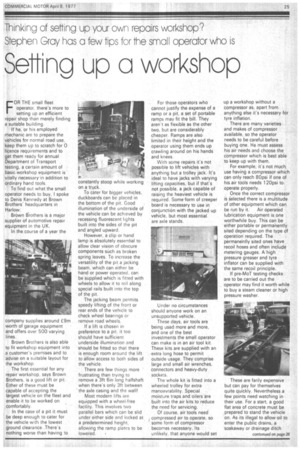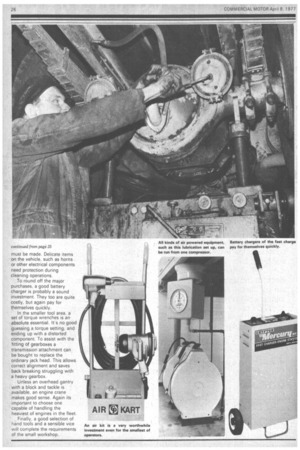F OR THE small fleet operator, there's more to setting up an efficient repair shop than merely finding a suitable building.
Page 27

Page 28

If you've noticed an error in this article please click here to report it so we can fix it.
If he, or his employed mechanic are to prepare the vehicles for normal road use, keep them up to scratch for 0 licence requirements and to get them ready for annual Department of Transport testing, a certain amount of basic workshop equipment is vitally necessary in addition to ordinary hand tools.
To find out what the small operator needs to buy, I spoke to Denis Kennedy at Brown Brothers headquarters in Harlow.
Brown rothers is a major supplier of automotive repair equipment in the UK.
In the course of a year the company supplies around £9m worth of garage equipment and offers over 500 varying lines.
Brown Brothers is also able to fit workshop equipment into a customer's premises and to advise on a suitable layout for the workshop.
The first essential for any repair workshop, says Brown Brothers, is a good lift or pit. Either of these must be capable of accepting the largest vehicle on the fleet and enable it to be worked on comfortably.
In the ease of a pit it must be deep enough to cater for the vehicle with the lowest .ground clearance. There's nothing worse than having to constantly stoop while working on a truck.. To cater for bigger vehicles, duckboards can be placed in the bottom of the pit. Good illumination of the underside of the vehicle can be achieved by recessing fluorescent lights built into the sides of the pit and angled upward.
However, a clip or hand lamp is absolutely essential to allow clear vision of obscure components such as broken spring leaves. To increase the versatility of the pit a jacking beam, which can either be hand or power operated, can be supplied which is fitted with wheels to allow it to roll along special rails built into the top of the pit.
The jacking beam permits speedy lifting of the front or rear ends of the vehicle to check wheel bearings or remove road wheels.
If a lift is chosen in preference to a pit, it too should have sufficient underside illumination and should be fitted so that there is enough room around the lift to allow access to both sides of the vehicle.
There are few things more frustrating than trying to remove a 3ft 6in long halfshaft when there's only 3ft between 'the axle casing and the wall!
Most modern lifts are equipped with a wheel-free facility. This involves two parallel bars which can be slid under either side and locked at a predetermined height, allowing the ramp plates to be lowered.
For those operators who cannot justify the expense of a. ramp or a pit, a set of portable ramps may fit the bill. They aren't as flexible as the other two, but are considerably cheaper. Ramps are also
limited in their height and the operator using them ends up crawling around on his hands and knees.
With some repairs it's not possible to lift vehicle's with anything buta trolley jack. It's ideal to have jacks with varying lifting capacities, but if that's not possible, a jack capable of raising the heaviest vehicle is required. Some-form of creeper board is necessary to Use in conjunction with the jacked up vehicle, but most essential are axle stands.
Under no circumstances should anyone work on an unsupported vehicle.
These days, air tools are being used more and more, and one of the best investments the small operator can make is in an air tool kit. These kits are supplied with an iextra long hose to permit outside usage. They comprise large and small air wrenches, Connectors and heavy-duty sockets.
The whole kit is fitted into a wheeled trolley for extra manoevrability. Special moisture traps and oilers are built into the air kits to reduce the need for servicing.
Of course, air tools need compressed air to operate, so some form of compressor becomes necessary. Its unlikely, that anyone would set up a workshop without a compressor as, apart from anything else it's necessary for tyre inflation.
There are many varieties and makes of compressor available, so the operator needs to be careful before buying one. He must assess his air needs and choose the compressor which is best able to keep up with them.
For example, it's not much, use having a compressor which' can only reach 80psi if one of his air tools needs 120psi to operate properly.
Once the correct compressor is elected there is a multitude of other equipment which can be run by it. Air operated lubrication equipment is one worthwhile buy. This can be either portable or permanently sited depending on the type of operation' required. The permanenfly sited ones have recoil hoses and often include metering gauges. A high pressure greaser and tyre inflator can be supplied with the same recoil principle.
If pre-MoT testing checks are to be carried out the operator may find it worth while to buy a steam cleaner or high pressure washer.
These are farily expensive but can pay for themselves quite quickly. Nevertheless a few points need watching in their use. For a start, a good flat area of concrete must be prepared to stand the vehicle 'on. As its illegal to allow oil to enter the public drains, a -soakaway or drainage ditch
must be made. Delicate items on the vehicle, such as horns or other electrical components need protection during cleaning operations.
To round off the major purchases, a good battery charger is probably a sound investment. They too are quite costly, but again pay for themselves quickly.
In the smaller tool area, a set of torque wrenches is an absolute essential. It's no good• guessing a torque setting, and ending up with a distorted component. To assist with the 'fitting of gearboxes a transmission attachment can be bought to replace the ordinary jack head. This allows correct alignment and saves back breaking struggling with a heavy gearbox.
Unless an overhead gantry with a block and tackle is available, an engine crane makes good sense. Again its important to choose one capable of handling the heaviest of engines in the fleet.
Finally, a good selection of hand tools and a sensible vice will complete the requirements of the small workshop.




























































































